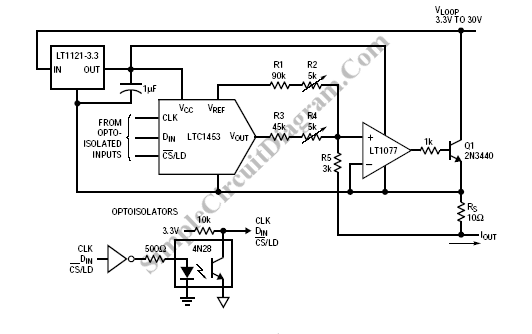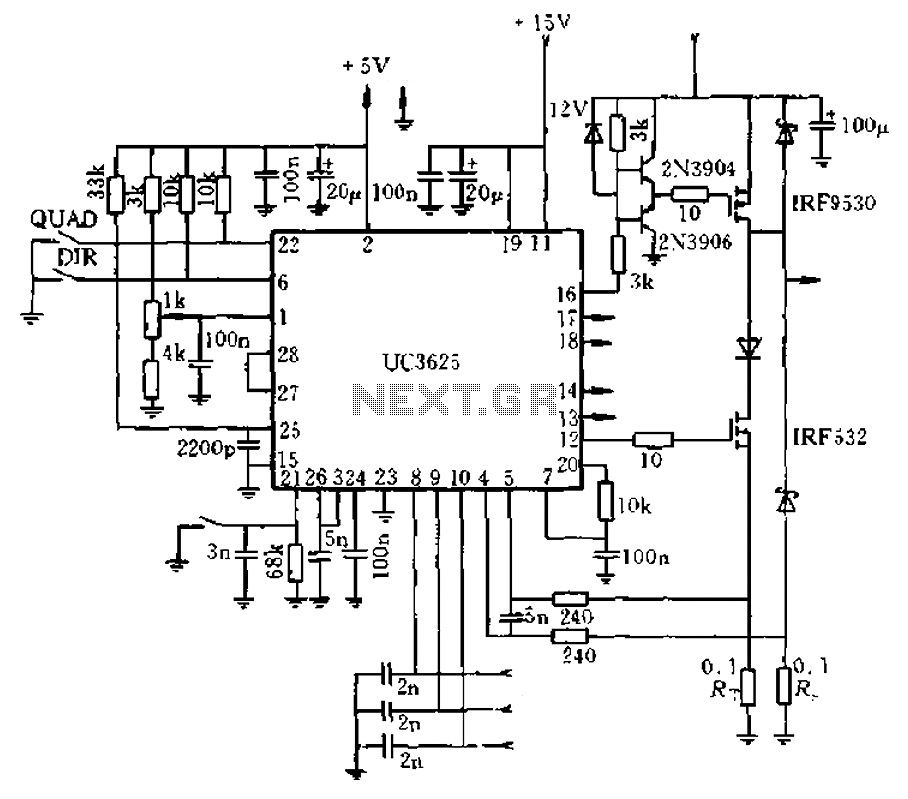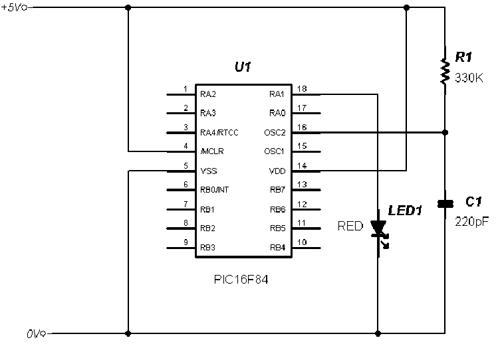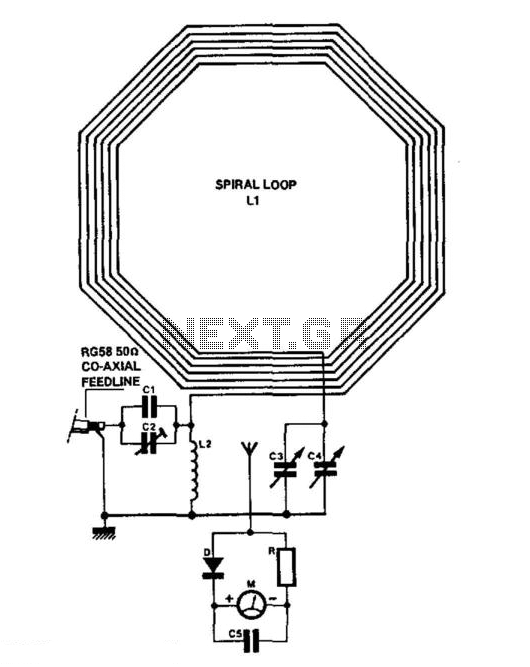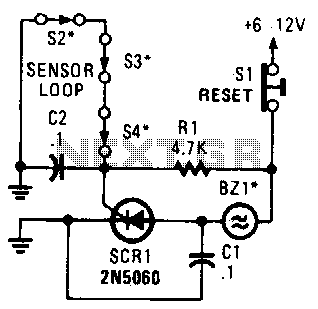
The ATL-3 Loop Antenna
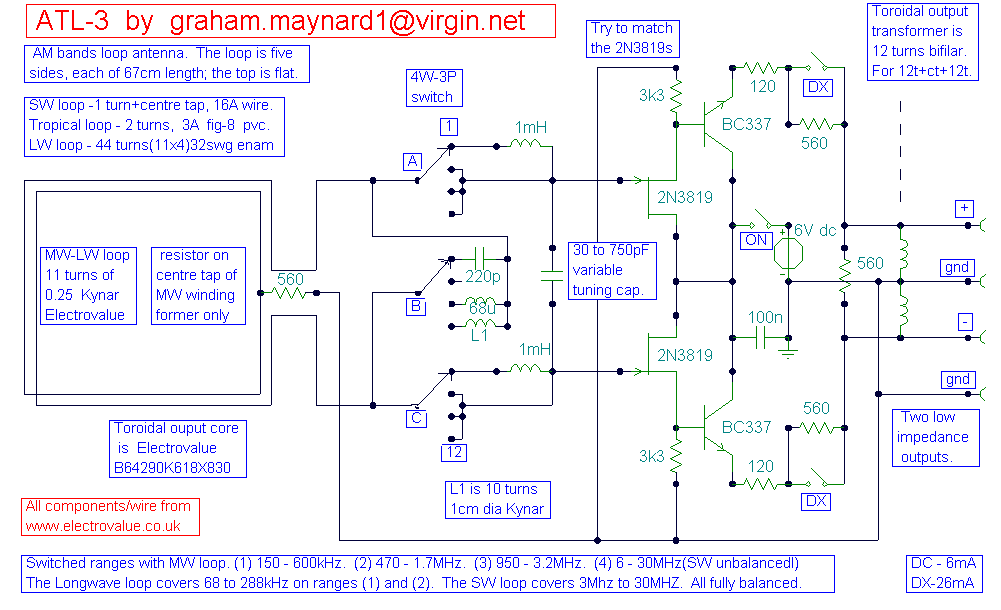
All ATL-3 loop windings are center-tapped and balanced with respect to their amplifier/receiver chassis ground, which leads to self-cancellation of electric field interference. Magnetic noise fields, such as those from televisions and electric meter boxes, or electromagnetically radiated interferences, can be minimized by adjusting the loop's orientation. When the received noise does not interfere with desired station reception, an indoor active loop can be quite beneficial. Tuned winding antennas typically offer a potential 6 dB greater signal sensitivity and a better signal-to-noise ratio compared to similarly sized broadband designs; hence, a significantly larger broadband loop area is required to outperform the standard 40-inch frame loop with direct magnetic amplification (d.m.a.) or an ATL-3. It is noteworthy that the switched ATL-3 amplifier circuit operates effectively from 150 kHz to 3 MHz with a seven-turn 40" medium wave (MW) box loop by simply extending a ground connection to a center tap located at the midpoint of the winding. Construction details for the 40" loop are available from MWC reprints. ATL-3 loop windings are designed as a five-sided spiral measuring 65 cm (26 inches) with a flat top, ensuring that they do not damage the radio during rotation. The winding turns are spaced 2 mm apart for the 11-turn MW loop, with the center tap positioned 5 turns in from the outer edge; the superior 44-turn long wave (LW) winding consists of 4 turns per eleven 2 mm spaced slots. Loop corner formers can be constructed from sections of unclad 0.1-inch matrix board sourced from Electrovalue, with the turns secured in place using varnish or paint after winding and prior to usage. Combining the loop signal with that from an outdoor wire or active whip antenna is recommended. The loop gain can be effectively doubled in one direction aligned with the loop, while achieving deep nulling in the opposite direction, which is particularly advantageous for UK DXers dealing with strong nighttime European skywaves. The control mechanisms do not need to be overly complex, as illustrated in the accompanying circuit diagrams.
The ATL-3 loop antenna system is designed to optimize reception in environments with various sources of electromagnetic interference. The center-tapped configuration allows for effective noise cancellation, making it suitable for urban areas where electric and magnetic fields are prevalent. The design of the loop windings as a five-sided spiral not only aids in maintaining a compact form factor but also reduces the risk of mechanical interference with nearby equipment during adjustment.
The antenna's tuned winding design significantly enhances its performance characteristics. By achieving a higher signal sensitivity, the ATL-3 loop provides a more favorable signal-to-noise ratio, which is critical for capturing weak signals in crowded frequency bands. The adaptability of the amplifier circuit to function across a wide frequency range (150 kHz to 3 MHz) ensures versatility in application, allowing users to adjust the setup based on specific reception needs.
Construction of the loop can be performed using commonly available materials, making it accessible for hobbyists and professionals alike. The suggested method for securing the windings with varnish or paint not only stabilizes the structure but also protects it from environmental factors that could affect performance.
In terms of signal processing, the ability to combine signals from multiple sources, such as outdoor antennas, enhances the overall reception capabilities. This feature is particularly beneficial for users in regions with high levels of interference, as it allows for selective amplification of desired signals while minimizing unwanted noise.
Overall, the ATL-3 loop antenna system represents a sophisticated solution for amateur radio enthusiasts and professionals seeking to improve their reception capabilities in challenging environments. Its thoughtful design and construction facilitate effective operation across a range of frequencies, providing users with the tools necessary to optimize their listening experience.All ATL-3 loop windings are centre tapped and balanced w. r. t. their amplifier/receiver chassis ground, and therefore electric field interference pick up tends to self cancel. Magnetic noise fields, e. g. televisions and the electric meter box, or electromagnetically radiated interferences, may be minimised by loop rotation.
Where the received noise does not degrade wanted station reception, an indoor active loop can be very rewarding. Tuned winding antennas always have a potential 6dB greater signal sensitivity, and provide a better signal to noise ratio than equally sized broadband designs; thus a much larger broadband loop area becomes necessary to better the performance of the standard 40 inch frame loop with d. m. a. , or an ATL-3. Note that the switched ATL-3 amplifier circuit will work just as well from 150kHz to 3MHz with a seven turn 40" MW box loop, by simply extending a ground connection to a centre tap at the middle of the winding.
40" loop construction details are already available from MWC reprints. ATL-3 loop windings are in the shape of a five 65cms. (26inches) sided spiral with flat top, so that they won`t bash your radio when you rotate them. Winding turns are 2mm. spaced for the 11 turn MW loop, with the centre tap 5t. in from the outside edge; the excellent 44 turn LW winding is comprised of 4 turns per eleven 2mm. spaced slots. Loop corner formers can be made from sections of unclad 0. 1 inch matrix board from Electrovalue, with the turns fixed in place with varnish or paint after winding, but before use. Do try combining your loop signal with the signal from an outdoor wire or active whip antenna. Whatever your loop gain, it can be doubled in one direction in line with the loop, with deep nulling in the opposite direction.
just what UK Dxers need to counter strong night-time EU skywaves. The controls do not need to be complicated, see the circuit drawings below. 🔗 External reference
The ATL-3 loop antenna system is designed to optimize reception in environments with various sources of electromagnetic interference. The center-tapped configuration allows for effective noise cancellation, making it suitable for urban areas where electric and magnetic fields are prevalent. The design of the loop windings as a five-sided spiral not only aids in maintaining a compact form factor but also reduces the risk of mechanical interference with nearby equipment during adjustment.
The antenna's tuned winding design significantly enhances its performance characteristics. By achieving a higher signal sensitivity, the ATL-3 loop provides a more favorable signal-to-noise ratio, which is critical for capturing weak signals in crowded frequency bands. The adaptability of the amplifier circuit to function across a wide frequency range (150 kHz to 3 MHz) ensures versatility in application, allowing users to adjust the setup based on specific reception needs.
Construction of the loop can be performed using commonly available materials, making it accessible for hobbyists and professionals alike. The suggested method for securing the windings with varnish or paint not only stabilizes the structure but also protects it from environmental factors that could affect performance.
In terms of signal processing, the ability to combine signals from multiple sources, such as outdoor antennas, enhances the overall reception capabilities. This feature is particularly beneficial for users in regions with high levels of interference, as it allows for selective amplification of desired signals while minimizing unwanted noise.
Overall, the ATL-3 loop antenna system represents a sophisticated solution for amateur radio enthusiasts and professionals seeking to improve their reception capabilities in challenging environments. Its thoughtful design and construction facilitate effective operation across a range of frequencies, providing users with the tools necessary to optimize their listening experience.All ATL-3 loop windings are centre tapped and balanced w. r. t. their amplifier/receiver chassis ground, and therefore electric field interference pick up tends to self cancel. Magnetic noise fields, e. g. televisions and the electric meter box, or electromagnetically radiated interferences, may be minimised by loop rotation.
Where the received noise does not degrade wanted station reception, an indoor active loop can be very rewarding. Tuned winding antennas always have a potential 6dB greater signal sensitivity, and provide a better signal to noise ratio than equally sized broadband designs; thus a much larger broadband loop area becomes necessary to better the performance of the standard 40 inch frame loop with d. m. a. , or an ATL-3. Note that the switched ATL-3 amplifier circuit will work just as well from 150kHz to 3MHz with a seven turn 40" MW box loop, by simply extending a ground connection to a centre tap at the middle of the winding.
40" loop construction details are already available from MWC reprints. ATL-3 loop windings are in the shape of a five 65cms. (26inches) sided spiral with flat top, so that they won`t bash your radio when you rotate them. Winding turns are 2mm. spaced for the 11 turn MW loop, with the centre tap 5t. in from the outside edge; the excellent 44 turn LW winding is comprised of 4 turns per eleven 2mm. spaced slots. Loop corner formers can be made from sections of unclad 0. 1 inch matrix board from Electrovalue, with the turns fixed in place with varnish or paint after winding, but before use. Do try combining your loop signal with the signal from an outdoor wire or active whip antenna. Whatever your loop gain, it can be doubled in one direction in line with the loop, with deep nulling in the opposite direction.
just what UK Dxers need to counter strong night-time EU skywaves. The controls do not need to be complicated, see the circuit drawings below. 🔗 External reference
